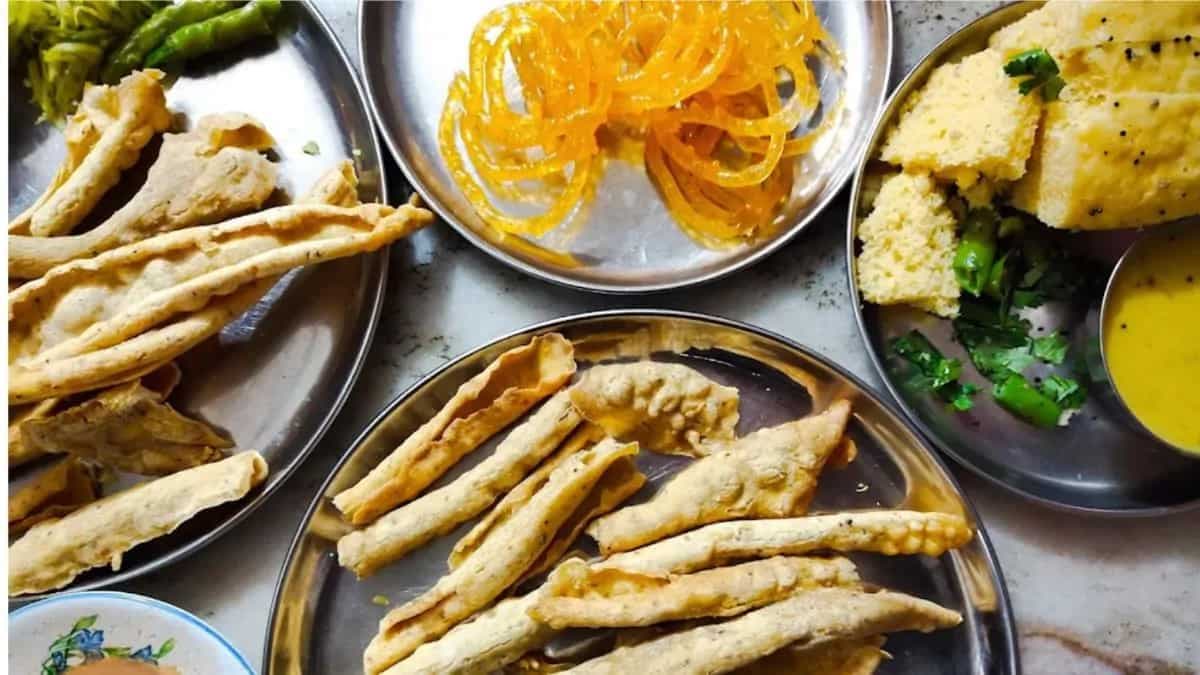Every region in India carries its own unique traditions for Vijayadashami, and Gujarat has shaped one of the most recognisable through the pairing of fafda and jalebi. On the morning of Dussehra, queues stretch outside sweet shops before sunrise, and the golden trays of jalebi with the thin, crackling strips of fafda become the shared breakfast of entire neighbourhoods. The reasons for this tradition go beyond food preference. They include ritual practices connected to the symbolic use of gram flour, the role of fermentation in festive cooking, and the influence of historic shops such as Chandravilas in Ahmedabad. Over the years, this pairing has moved from being a local delicacy to a cultural emblem that defines the festival in Gujarat.

The Festival Connection
Dussehra marks the victory of good over evil and follows the nine nights of Navratri. On this day, families perform rituals at home and in community spaces, and food plays a significant role in bringing together the symbolic and the celebratory. In Gujarat, fafda is made from gram flour dough seasoned with spices, which is rolled and fried into long, crisp strips. Jalebi, on the other hand, uses fermented batter piped into hot oil and soaked in sugar syrup, creating coils that shine when freshly made. The contrast of savoury and sweet appears festive, but its significance also lies in ritual associations. Gram flour has long been considered auspicious during Navratri, as it is prepared without grains of rice or wheat that are often avoided during fasting. The use of fermented batter in jalebi connects to renewal and prosperity, marking the transition from nine days of devotion to the joyous conclusion on Vijayadashami.

Preparations By Sweet Shops
On the night before Dussehra, sweet shops across Gujarat remain open through the hours, preparing large volumes of fafda and jalebi for the following morning. The demand is so high that shops often hire extra staff and set up large woks in open spaces, with jalebi being fried and placed directly into syrup while trays of fafda cool on side tables. The preparation requires precision because both items must be served fresh to retain their characteristic taste and texture. Jalebi needs to be crisp but also soaked evenly with syrup, while fafda must break cleanly without becoming oily. In many towns, families arrive as early as four in the morning to collect their orders, and queues are seen outside heritage establishments that have been serving the combination for generations.

The Story Of Chandravilas, Ahmedabad
The tradition of fafda-jalebi in Ahmedabad and beyond owes much to the story of Chandravilas, which has stood since 1900. Founded by Chimanlal Hemraj Joshi, Chandravilas began as a modest tea shop in the old city. In time, the family expanded the menu to include fafda and pure ghee jalebi, creating a combination that soon became iconic in Ahmedabad. Customers came to associate the pairing with breakfast, and while it was enjoyed throughout the year, it took on special meaning during Dussehra. Over decades, this connection became so strong that fafda-jalebi turned into the unofficial festive breakfast of Vijayadashami across Gujarat.

Today, the shop is managed by the third generation, with Malav Joshi continuing the legacy. Chandravilas has welcomed film stars, political leaders, and international guests, and it continues to be seen as the place that shaped the tradition. Malav Joshi described the journey in his own words:
“Our grandfather started Chandravilas as a tea shop, and then he began making fafda along with pure ghee jalebi. The combination became very iconic, and people started coming to us every morning for it. Over the years, it became linked with Dussehra, when people began treating fafda-jalebi as the breakfast of the festival. Even today, we prepare through the night, and the crowds never stop from morning until evening. The tradition has travelled across India and the world, but it all began here in Ahmedabad.”

Cultural Symbolism Of The Pairing
The presence of both fafda and jalebi on Vijayadashami is not merely practical but layered with symbolic meaning. Fafda, made of gram flour, is associated with strength and continuity, linking directly with rituals that call for pure and simple ingredients at the close of Navratri. Its long strips are sometimes seen as a representation of victory and longevity. Jalebi, with its spiral form and bright colour, represents joy and abundance, as well as the sweetness of life after the austerity of nine nights of fasting and devotion. When served together, the balance of savoury and sweet reflects harmony, which is central to the spirit of Vijayadashami. This symbolic reading has reinforced the tradition over time, making fafda-jalebi not just a matter of taste but a meaningful expression of cultural identity.

Influence Beyond Gujarat
The spread of fafda-jalebi outside Gujarat is closely tied to the reputation of Chandravilas. Visitors to Ahmedabad carried the memory of the pairing to other parts of India, and the Joshi family’s insistence on keeping the tradition alive ensured that it remained connected with Dussehra. Gujarati families who settled in Mumbai, Pune, and Delhi soon sought the combination as part of the festival, and sweet shops in those cities began offering it. Over time, the Gujarati diaspora introduced it in the United States, the United Kingdom, and East Africa, where community gatherings now feature fafda-jalebi on Vijayadashami mornings. Many shops across India advertise festive specials during Navratri and Dussehra, but the role of Chandravilas as the origin point is acknowledged widely. The pairing spread because of their influence, and their legacy continues to anchor it as a cultural emblem of Gujarat.


